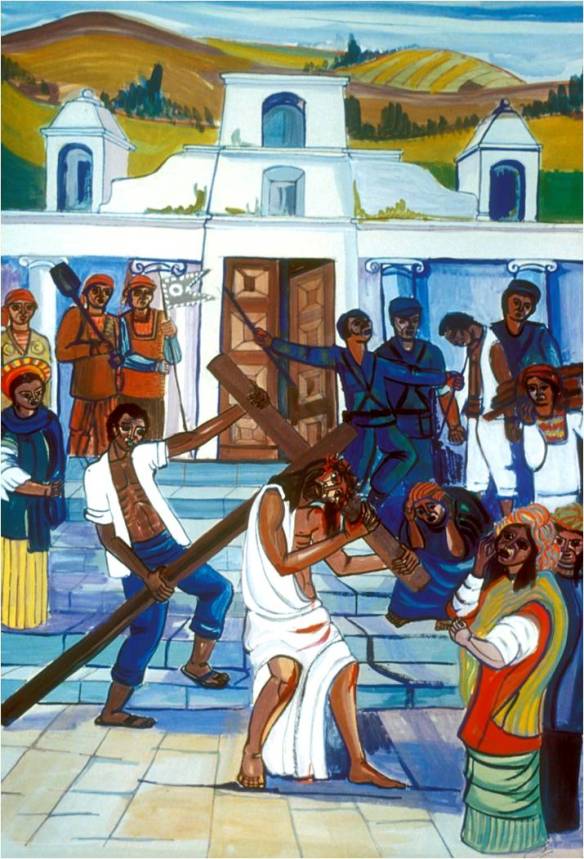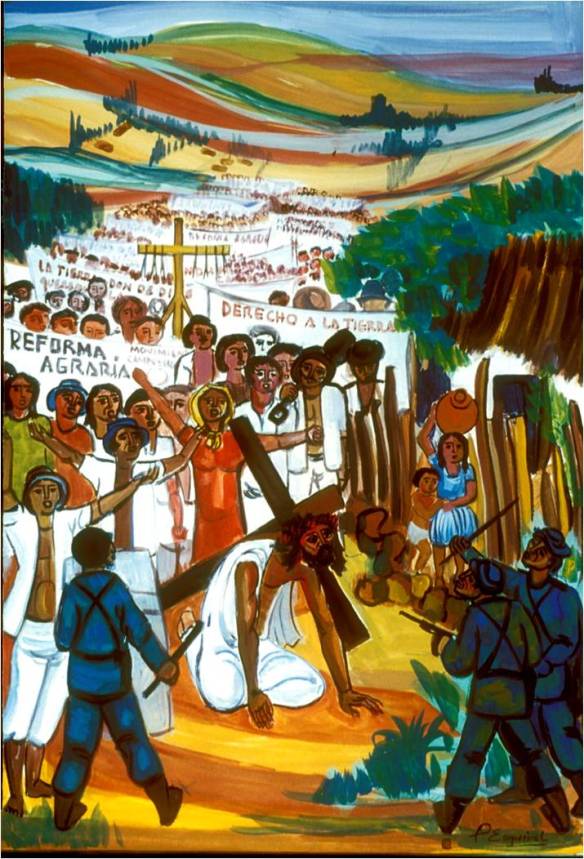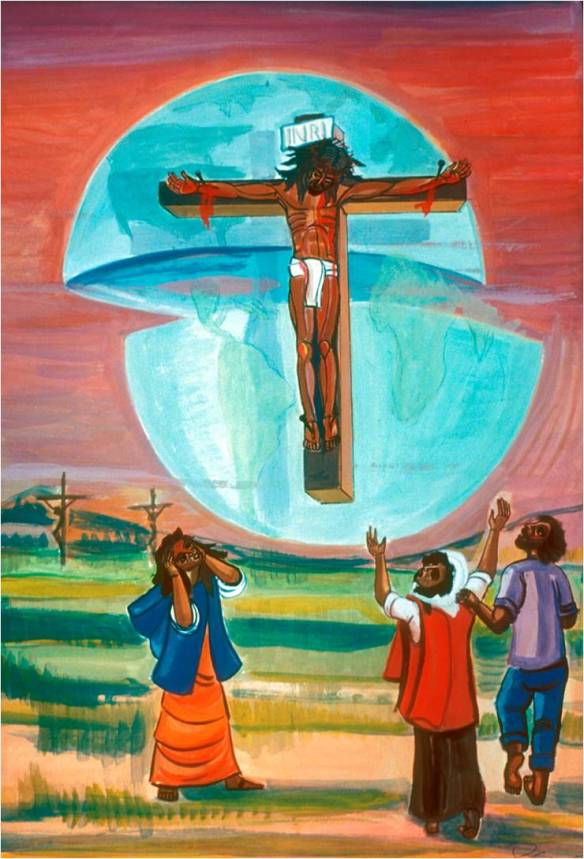Prolog
Bahan ini saya peroleh dari guru saya di Ateneo beberapa tahun yang lalu. Aslinya dalam bentuk power point seperti tertera dalam alamat URL di bawah. Tapi ketika saya klik kok malah membingungkan. Mungkin karena saya gaptek (gagap teknologi). Maka saya post dalam bentuk word biasa saja untuk memberi kemudahan bagi orang-orang yang juga gaptek seperti saya.
Masih dalam bahasa Inggris dan konteksnya juga Amerika Latin, yang sarat dengan penindasan dan permasalahan sosial. Mungkin materi jalan salib teologi pembebasan ini bisa memberi inspirasi bagi teman-teman sekalian untuk menyusun sebuah doa jalan salib yang sesuai dengan konteks sosial di mana kita terlibat di dalamnya.
Salam – VG.
*********************
By Adolfo Pérez Esquivel of Argentina
(Nobel Peace Prize Laureate, 1980)
Stations of the Cross from Latin America 1492 – 1992
This presentation has been posted here in response to the question, “What is liberation theology?” Esquivel’s 15 Stations of the Cross are on slides 2–16. They were originally to mark the 500th anniversary of the colonisation of the Americas. For background, see slides 17-18. Use the scroll bar on the right to scan through them. Right click and choose “full screen” for best viewing. The commentary alongside each is by Alastair McIntosh of Scotland. It is based around, but builds upon, original text from the CIDSE agencies (Coopération Internationale pour le Développement et la Solidarité) that distributed the images.
*******************
I. Condemnation to death
 “Pilate handed Jesus over to be crucified.” (Mark 15:15)
“Pilate handed Jesus over to be crucified.” (Mark 15:15)
Theme – Human Rights – Christ is led from prison, watched by the mothers of the Plaza de Mayo in Buenos Aires – the mothers of the disappeared. Their posters read: “No more repression” and “Where is my son?” Jesus himself is also a victim of false accusations, of unfair arrest and torture. And in the 21st century, European airports have been used by America for “extraordinary rendition” torture flights in violation of human rights, and people jailed for years without trial in Guantanamo Bay.
**
II. Rejected and Abandoned
“And carrying his own cross he went out of the city.” (John 19:17)
Theme – The Loneliness of Cities – Christ in the scarlet mocking coat is arrested in the city of São Paulo. The “Roman” soldiers are armed not with swords, but guns. Meanwhile, most people go about their daily business, turning a blind eye to and taking no action over the tyranny being played out before them. The only witnesses are a shoe-shine boy and an elderly couple – people of low social status. Liberation theology is “contextual theology” – the stories about Jesus are contextualised in our world today, for we imprison them if we trap them in the past.
**
III. Crushed by the Cross
“He has sent me to set the downtrodden free.” (Luke 4:19)
Theme – War & Civil Wars – Jesus falls for the first time under the burden of the Cross. Brutal violence has weighted him down, just like that which afflicts peasants, farm workers and the urban poor today. In the foreground we see Archbishop Oscar Romero of El Salvador, a man of peace who was assassinated at the altar when celebrating Mass on 24 March 1980. Jesus never taught “just war theory”; he taught nonviolence, telling Peter to put away his sword – “No more of this” (Luke 22:51). As such, the cross becomes the supreme symbol of nonviolence – the power of love that exceeds the love of power.
**
IV. Mother and Son
“His mother stored up all these things in her heart.” (Luke 2:51)
Theme – Suffering, Solidarity and Community – In one of the favelas or urban slums of Latin America, Mary, overwhelmed with grief, meets her condemned son. The people lack such essentials for life as safe water, sanitation, nutritious food, transport and “wonted” work – work that is meaningful. In spite of this, they survive by self-help and solidarity that builds community. Mary’s suffering is that of all those who are unable to do enough to save their loved ones. It is our suffering, too, when beauty is crushed around us and we are unable to do enough to save our world.
**
V. Helped by an Outsider
“They compelled a passer-by who was coming in from the country, to carry his cross.” (Mark 15:21)
Theme – Racial Prejudice – Simon of Cyrene is portrayed as one of the millions of black people living in Latin America – descendents of those who were brought there under slavery while the native Amerindians were being exterminated. This ethnic group have the lowest status in Latin America. They are often subject to “victim blaming” – a form of prejudice where the powerful scapegoat the powerless to justify their power. Because of this, Paulo Freire of Brazil said that the great work of the oppressed is to liberate both themselves, and their oppressors!
**
VI. Community of the Oppressed
“If you did this to the least of my people, you did it to me.” (Matthew 25:40
Theme – Indigenous Peoples – Of the 22 million Aztecs alive in 1519 when Hernán Cortez entered Mexico, only a million remained by 1600. Here, Indian women represent Saint Veronica. They have wiped the face of Jesus. His features, now imprinted on the cloth, are their features. Could they be ours too? Once, we were all indigenous peoples. Perhaps today we must rediscover this quality if we are to re-make communities of place and care for the Earth whereon we tread. But we must shape identity inclusively – just as Jesus was challenged to be inclusive by the Canaanite woman (Mark 7:24-30).
**
VII. The Land Question
“Give us this day our daily bread.” (Matthew 6:11)
Theme – The Landless Poor – Jesus falls for the 2nd time under the weight of the cross. Each rope on the cross that can be seen amongst the land reform (Reforma Agraria) marchers represents a murdered Campesino – “Derecho a la tierra – Right to the land,” say their banners. Jesus taught people to pray for bread, and he rejected the temptation of landed power (Luke 4:5-8). Today, 2.25% of the people of Guatemala own 64% of the land. And rich landowners representing 0.08% of the population claim to control 80% of Scottish land. But we’re learning from the South with the Land Reform (Scotland) Act 2003.
VIII. The Outcry of the Women
“Many women cried and lamented for him.” (Luke 23:27)
Theme – Women’s Empowerment – Full of compassion the women bewail the fate of Jesus. He, however, refers them to their own fate: “Do not weep for me…” The Biblical scene is transferred to Ayacucho, Peru, where many fathers and sons are killed and the women are left alone to provide for their families. They say: “Yesterday in the Bible group we read how the people of Israel were oppressed in Egypt. Aren’t we in the same position? God wants to lead us to the promised land too. We should discuss this with the others!”
**
IX. Cast Out and Abused
“Whoever welcomes such a child in my name welcomes me.” (Mark 9:37)
Theme – Children in Need – Jesus falls for the 3rd time, amid homeless children and unemployed youth. In Brazil hundreds of street children were murdered by death squads every year. In Scotland, youth at Govan’s GalGael Trust, who started on drugs as young as 12, say: “I took heroin because it took away the pain; but it also took away my soul.” Alice Miller’s work shows how a child not loved for itself – in its “primal integrity” – becomes destructive. Christ took children in his arms and blessed them. As a child, he himself was a refugee in Egypt, and Joseph’s love made him socially acceptable through fostership.
**
X. Destruction of the Rainforests
“They divided his garments among them.” (Matthew 27:35)
Theme – The Death of Nature – Jesus is stripped of his clothes by soldiers who gamble for them. In the same way, the Earth is stripped of her clothes – her soils, waters and forests – to fuel our great casino economy where need is dwarfed by greed. As the “Roman” soldiers prepare to crucify Jesus, the Brazilian environmentalist and rubber-tappers’ union leader, Chico Mendes, lies assassinated in the foreground (22 Dec 1988). To Jesus, the Earth was God’s “footstool” – the sacred resting place of divine presence (Matthew 5:35).
**
XI. Nailed to the Cross
“You cannot serve both God and money.” (Matthew 6:24)
Theme – The Debt Crisis – Jesus is nailed to the cross, just as the poor are nailed by the rich through monetarism and the sin of usury (making money out of money by lending only for interest). Investors may think they’re innocently seeking “the best rate of return,” but so doing drives an economic system where the poor supply unearned income to the relatively rich. In this picture, the poor carry resources up the scaffold, transferring wealth from South to North. Might Christians consider learning from attempts within Islamic banking to overcome usury, as well as by promoting “Fair Trade”? (Ezekiel 28 & Rev. 18:11-18).
**
XII. Death on the Cross
“But Jesus gave a loud cry and breathed his last.” (Mark 15:37)
Theme – A World Ripped Apart – The whole world is crucified by the spirit of violence. The two halves – rich and poor, North and South, Heaven and Earth – have been pulled asunder, yet still the Cross unites them. It is love that hangs crucified; a love that transcends even tortured death. All who take risks and put their necks on the line for justice in this world stand here in solidarity. Amongst this “communion of the saints” are those powerless to do anything but testify with their powerful presences – “the spirituality of the foot of the Cross.” Such, often, is our Station.
XIII. The Seed of Hope
“If a grain of wheat dies, it bears much fruit.” (John 12:24)
Theme – Base Communities – Jesus is taken down from the cross. The people gather in anticipation of Easter. All around the world, small groups gather, “For where two or three are gathered together in my name, there am I in the midst of them” (Matthew 18:20). Jesus was a man who died, but “Christ” is an understanding of the deathless spirit of life as love made manifest, beyond gender (Galatians 3:28). We might see this as alive in all, also in other faiths. Where institutional churches flee, ego-inflated, from such mystical insight, “base communities” of grassroot seekers of truth can rise above “spiritual materialism” and so renew God’s “church”.
**
XIV. Walking in the Shadow of Death
“Joseph took the body, wrapped it in a linen cloth and laid it in his own tomb.” (Matthew 27:59)
Theme – Return to the Earth – Jesus is laid to rest in a tomb, here beside a rubbish tip in a polluted industrial nation. We come from the clay of Mother Earth’s womb, are nourished from the fields, and in the end return to the soil – ashes to ashes, dust to dust – at one with rock-building geological processes set in time when place began. “I lift a stone; it is the meaning of life I clasp,” said the Scots bard, Hugh MacDiarmid, in On a Raised Beach: “We must reconcile ourselves to the stones…/ Though slow as the stones the powers develop/ To rise from the grave – to get a life worth having.”
**
XV. Triumph of Life
“Why do you seek the living among the dead? He is not here but has risen” (Luke 24:5).
With the ships of the Conquistadors and the factories of globalisation in the background, Christ out in nature with the sun symbolically overhead leads a march of landless Campesinos with martyrs of the struggle, including … Alice Dumont (Argentina), Santa Dias da Silva (Brazil), Oscar Romero (El Salvador), Chico Mendes (Brazil), Ita Ford (El Salvador), Zumbi (Brazil), Dana Tingo (Dominican Republic), Luisito Torres (El Salvador), Tupac Amaru (Peru), Enrique Angel Angelelli (Argentina), Luis Espinal (Bolivia) and Vicente Menchu (Guatemala). R.I.P. (See next slide for exegesis).
*********************************************************
The15th Station and Mystical Experience
 (Picture of Adolfo Pérez Esquivel – the artist)
(Picture of Adolfo Pérez Esquivel – the artist)
In preparing the commentaries shown to the right of each slide, I have drawn from text published in 1992 by Misereor of Germany and also from the 1992 CIDSE handbook (Way of the Cross from Latin America), that accompanied the original 35 mm photographic slides from which this presentation was digitised. Bible passages are also as given by CIDSE. Commenting upon the “Easter Picture,” “Lenten Veil” or “Hunger Cloth” that comprises the15th and final Station, the CIDSE booklet had this to say:
“Mystical experience is of central importance in Liberation Theology. Jesus can be experienced in and with those who suffer. For those who have faith, the act of turning to the oppressed, of serving the poor, of search for freedom from exploitative structures, is also an act of love for the suffering Christ. By the same token, the resurrection will be experienced whenever life is defended. Furthermore, all life which is oppressed and extinguished by power is included in the resurrection. This concept is expressed by Adolfo Perez Esquivel in his Easter picture.”
Background to this Material
As a Scottish Quaker of universalist disposition and Presbyterian background, it seems a little strange to be placing onto the web devotional material that was widely distributed by the Roman Catholic church in 1992, but has since vanished from view. I have searched the web, but in vain, to locate the material for use in my teaching and activism. I therefore resorted to having my own 35 mm transparency set scanned.
I first came across Esquivel’s “Way of the Cross” paintings through the Scottish Catholic International Aid Fund (SCIAF) – the official overseas relief agency of the Scottish Catholic bishops. Between the late-eighties and 1999, I was the only non-Catholic serving on their Management Committee, laterally as Chair of the Projects’ Committee, which then disbursed £2 million of grants annually in accordance with what radical Catholics call “Our best kept secret” – namely, their church’s rich and challenging social teaching.
At that time, liberation theology was being vibrantly supported and celebrated within Catholic agencies and especially SCIAF. This made it easy for me to participate, enthusiastically, in their work – something I had actually begun in 1977, when Voluntary Service Overseas had posted me, rather surprisingly, to work for two years with Archbishop Virgil Copas and the Missionaries of Charity sisters in Gulf Province, Papua New Guinea, as a vocational school deputy-headteacher and wiring up micro hydro-electric schemes.
Esquivel’s “Stations of the Cross” exemplified my admiration for radical Catholic theology which I saw as speaking to all who understand God as love. The images were distributed in Europe by CIDSE – the umbrella organisation of such Catholic relief agencies as Misereor, CAFOD, Trócaire and SCIAF.
I am puzzled as to why Esquivel’s iconic paintings seem now to have fallen into oblivion. I’d have thought that one of the big Catholic agencies might have put them on the web, the better to teach what liberation theology means. But this has not happened, so here they are – and I would welcome any opportunity that might arise to thank and ask the formal blessing of Adolfo Pérez Esquivel.
Christmas 2005 (23 Dec)
Alastair McIntosh, Scotland















Dear Veronika
I am Alastair McIntosh in Scotland, and a Google alert showed me to your blog and the uses you have made of the liberation theology material of Esquivel’s that I scanned and put on the web.
I just wanted to say how very pleased I am to see that you are using this in Indonesia.
Many years ago I travelled for 3 days on a cargo boat from Ujung Pandang to Jakarta. The Indonesian people were very kind, and the captain even insisted that we shared his cabin and food.
Best wishes
Alastair.
SukaSuka
Dear Sir,
Thank you very much for your quick response. I would like to express my gratitude for the material which you published. It is inspiring me a lot. I copied it from my lecturer, Fr. Percy Bacani MJ, when studying in Pastoral Ministry Program, Atheneo de Manila University some years ago.
I ask your forgiveness for posting it in my blog before asking your permission. I change your power point into the MS Word, so people can read it easily when opening the blog. In the end of this post, I put your URL, hope people will refer there to see the original one.
I share it in a purpose to give inspiration to friends involving in the social empowerment in Indonesia. I hope they can arrange a liturgy of station of the cross which is agreeable with our social context in Indonesia.
I am glad to know that you visited Indonesia. Thank you for your appreciation about our people. I live in Lampung Province, in south part of Sumatera island, just 30 minutes flight from Jakarta, the capital. I work as a lecturer in a college and also a pastoral worker in the diocese. Come again in Indonesia, don’t forget to visit me in my province. You are most welcome.
How far we are separated, but how close we are connected by our Lord.
United in prayers:
Veronika Gunartati
SukaSuka
It’s so lucky for me to find your blog! So shocking and great!
Christian
SukaSuka
Hmmm…thanks
SukaSuka
Happy Easter 2010!
SukaSuka
Reblogged this on PacificPilgrim and commented:
A great presentation of Esquivel’s “The Way of the Cross.”
SukaDisukai oleh 1 orang